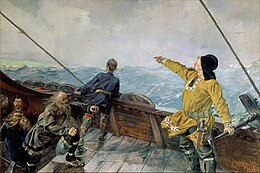
Back Grēnelandes Norren sprǣc ANG Nòrdic groenlandès Catalan Grónská severština Czech Nórdico groenlandés Spanish Norrois du Groenland French Grönlandi norvég nyelv Hungarian Bahasa Nordik Greenland ID グリーンランドノルド語 Japanese Гренландский язык (германский) Russian Grönländsk nordiska Swedish
| Greenlandic Norse | |
|---|---|
| Region | Greenland; Western Settlement and Eastern Settlement |
| Ethnicity | Greenlandic Norse people |
| Extinct | by the late 15th century or the early 16th century |
Indo-European
| |
Early forms | |
| Younger Futhark | |
| Language codes | |
| ISO 639-3 | None (mis) |
| Glottolog | None |
| IETF | non-GL |
| Part of a series on the |
| Norse colonization of North America |
|---|
 |
Greenlandic Norse is an extinct North Germanic language that was spoken in the Norse settlements of Greenland until their demise in the late 15th century. The language is primarily attested by runic inscriptions found in Greenland. The limited inscriptional evidence shows some innovations, including the use of initial t for þ, but also the conservation of certain features that changed in other Norse languages. Some runic features are regarded as characteristically Greenlandic, and when they are sporadically found outside of Greenland, they may suggest travelling Greenlanders.
Non-runic evidence on the Greenlandic language is scarce and uncertain. A document issued in Greenland in 1409 is preserved in an Icelandic copy and may be a witness to some Greenlandic linguistic traits. The poem Atlamál is credited as Greenlandic in the Codex Regius, but the preserved text reflects Icelandic scribal conventions, and it is not certain that the poem was composed in Greenland. Finally, Greenlandic Norse is believed to have been in language contact with Greenlandic and to have left loanwords in it.
- ^ Hammarström, Harald; Forkel, Robert; Haspelmath, Martin; Bank, Sebastian (24 May 2022). "Older Runic". Glottolog. Max Planck Institute for Evolutionary Anthropology. Archived from the original on 13 November 2022. Retrieved 13 November 2022.